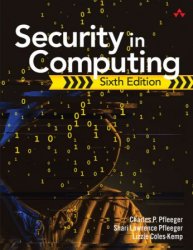 Название: Security in Computing, 6th Edition (Final)
Название: Security in Computing, 6th Edition (Final)Автор: Charles Pfleeger, Shari Lawrence Pfleeger, Lizzie Coles-Kemp
Издательство: Addison-Wesley/Pearson
Год: 2024
Страниц: 1026
Язык: английский
Формат: pdf (true), epub
Размер: 12.6 MB
The New State of the Art in Information Security: From Cloud to Crypto, AI-Driven Security to Post-Quantum Computing.
Now extensively updated throughout, Security in Computing, Sixth Edition, is today's one-stop, primary text for everyone teaching, learning, and practicing information cybersecurity. It defines core principles associated with modern security policies, processes, and protection; illustrates them with up-to-date sidebars and examples; and shows how to apply them in practice. Modular and flexibly organized, it supports a wide array of courses, strengthens professionals' knowledge of foundational principles; and imparts a more expansive understanding of modern security.
This edition adds or expands coverage of artificial intelligence and machine learning tools; app and browser security; security by design; securing cloud, IoT, and embedded systems; privacy-enhancing technologies; protecting vulnerable individuals and groups; strengthening security culture; cryptocurrencies and blockchain; offensive cyberwarfare; post-quantum computing; and more. It contains many new diagrams, exercises, sidebars, and examples, and is mapped to two leading frameworks: the US NIST National Initiative for Cybersecurity Education (NICE) and the UK Cyber Body of Knowledge (CyBOK).
Because programmers make mistakes of many kinds, we can never be sure all programs are without flaws. We know of many practices that can be used during software development to lead to high assurance of correctness. This chapter surveys programs and programming: errors programmers make and vulnerabilities attackers exploit. These failings can have serious consequences, as reported almost daily in the news. However, there are techniques to mitigate these shortcomings. In this section we presented several characteristics of good, secure software. Of course, a programmer can write secure code that has none of these characteristics, and faulty software can exhibit all of them. These qualities are not magic; they cannot turn bad code into good. Rather, they are properties that many examples of good code reflect and practices that good code developers use; the properties are not a cause of good code but are paradigms that tend to go along with it. Following these principles affects the mindset of a designer or developer, encouraging a focus on quality and security; this attention is ultimately good for the resulting product and for its users.
Cryptography is a specialized topic that depends on several areas of mathematics and theoretical computer science, including number theory, finite field algebra, computational complexity, and logic. After reading this overview, you would need to develop a significant background to study cryptography in depth. And we caution you strongly against studying a little cryptography and concluding that you can design your own secure cryptosystem. The field of cryptography is littered with failed approaches designed even by experts, so nonexperts are well advised to “leave the driving to the professionals.”
Remember from Chapter 2 that cryptanalysis is the act of studying a cryptographic algorithm, its implementation, plaintext, ciphertext, and any other available information to try to break the protection of encryption. A cryptanalyst’s chore is to break an encryption. That is, the cryptanalyst attempts to deduce the original meaning of a ciphertext message. Better yet, the cryptanalyst hopes to determine which decrypting algorithm, and ideally which key, match the encrypting algorithm to be able to break other messages encoded in the same way.
Core security concepts: Assets, threats, vulnerabilities, controls, confidentiality, integrity, availability, attackers, and attack types
The security practitioner's toolbox: Identification, authentication, access control, and encryption
Areas of practice: Securing programs, userinternet interaction, operating systems, networks, data, databases, and cloud computing
Cross-cutting disciplines: Privacy, management, law, and ethics
Using cryptography: Solve real problems, and explore its formal and mathematical underpinnings
Emerging topics and risks: AI and adaptive cybersecurity, blockchains and cryptocurrencies, computer-assisted offensive warfare, and quantum computing
Contents:
Скачать Security in Computing (Sixth Edition)
True PDF:
ePub:
